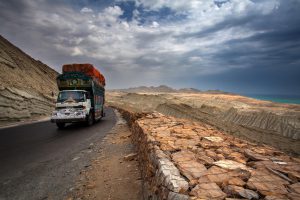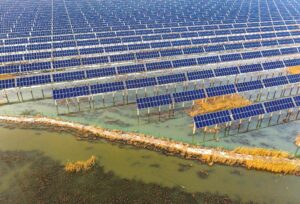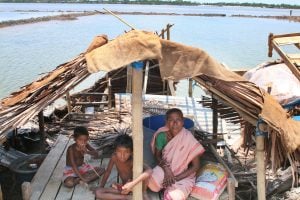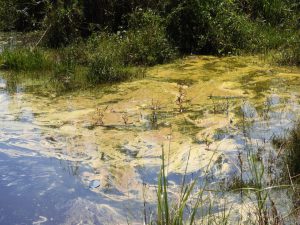“What is the point in rebuilding our house,” asks Santanu Haldar, “when we know it will be torn down in the next storm? Would anyone want to do it?”
Making landfall with a wind intensity of 165-175 kilometres per hour, gusting up to 185 kmph, Cyclone Amphan flattened all mud huts as it raced up the Sundarbans and through Kolkata on the evening of May 20.
Five days later, Haldar pans his phone to show a scene of utter devastation in Mousuni, a village that faces the Bay of Bengal and was right next to the eye of the strongest cyclone since regular records began in 1982. You can see only the plinths of mud huts – the rest has been blown and washed away; all the trees are flattened; instead of the paddy crop that was standing when the cyclone arrived, you can only see puddles; dead fish cover pond surfaces – saltwater flooded the ponds and killed all the fish, which are rotting now.
Next to Mousuni and right on the mouth of the Hooghly – the westernmost distributary of the Ganga – Ganesh Chandra Das of Sagar Island says you should ask your questions quickly. There is still no electricity in the entire delta, four days after the storm he managed to charge his phone at a shop with a diesel generator after paying INR 10 (USD 0.13), and now the charge is running out.
Das is the local coordinator of Sobuj Sangha (Green Group), a respected NGO that has been working hard to safeguard the residents of Sagar Island from sea level rise. “It all seems so meaningless now,” he said, referring to the mangrove plantations he had proudly shown to this reporter last August. “The waves came right through those plantations and flattened all the huts and ponds and farms we were trying to protect. The soil has turned salty. For at least three years, nothing can grow there.”
See: Rising sea swamps island along Bengal coast
His own house has lost its asbestos roof. “All the brick and cement houses that had asbestos, tin or tile roofs are now roofless. We are staying in a tent, and we have no idea how long it will take to get a roof over our heads again. The monsoon is less than a month away. We can’t stay in a tent then. We don’t know what we’ll do.”
The West Bengal government has moved relief material to the area, in the form of food, tarpaulin sheets for tents and bottled water. The mainland jetty to reach Sagar Island has collapsed in the cyclone, and ferry services are still suspended, but fishing trawlers are being used to transport relief material. “We have received enough food and tarpaulin sheets for now,” says Das. “We need more drinking water. We can’t drink the pond water any more – it’s salty and putrid. We also need a lot more disinfectant. It stinks of rotting fish everywhere, and an epidemic can break out any moment.”
This is a region where hundreds of thousands of migrant workers returned home as they lost their jobs due to the nationwide lockdown forced by Covid-19. Thousands of them were quarantined in the same office, college and school buildings that have been used as cyclone shelters for the last two decades. As Cyclone Amphan barrelled towards West Bengal, the authorities moved around 200,000 residents to these same shelters as nothing else was available.
See: People rush back to the Sundarbans, untested
The quick evacuation has saved thousands of lives. But being packed indoors with suspected Covid-19 patients endangers everyone. The evacuees want to go home, but there is often no home to go to. They have started moving back in trickles and are rebuilding their mud huts.
The heavy rain brought to northeastern India in the last hours of Cyclone Amphan has led to floods in the neighbouring state of Assam as well. At the beginning of last week, the Assam Disaster Management Authority had decided that due to Covid-19, everyone evacuated due to floods this year would have double the space usually allocated – 7 square metres per head instead of 3.5. Now the authorities are struggling to implement the new norm with hardly any notice.
In the meanwhile, those wanting to return to their erstwhile homes are asking the same question as Haldar – what is the point in rebuilding? Apart from the danger of another cyclone in an area that has seen 26% intensification of cyclones in the past century, there is no livelihood option that any resident can see now. Their farmlands have turned salty and barren, their freshwater ponds are contaminated with sea water, and there is no industry in the area. Most of the residents were dependent on remittances that have been reduced to zero due to the lockdown.
“I used to work as a mason in Kerala,” says Haldar. “Like everyone else, I lost my job when Covid-19 broke out and the lockdown was announced. I spent the little savings I had getting back to my village. What do I do now? I shall ring our contractor as soon as the lockdown is over and see if he will take me back.”
Nilanjan Ghosh, head of the Kolkata chapter in Observer Research Foundation, says the southernmost one-third of the Sundarbans has become uninhabitable, and around 1.5 million people need to be relocated. It is an argument he has been making for a decade now, but he has received no positive response from policymakers, who are afraid of the chaos such a move may cause.
But with the sea rising in the area at a rate of 8 millimetres per year, with cyclones becoming more frequent and more severe as another result of climate change, and with the Ganga delta itself sinking due to silt being held back by numerous dams and barrages upstream, there may soon be no alternative but to depopulate a part of the world’s largest mangrove forest.
![<p>A house completely devastated in the aftermath of Cyclone Amphan [image: Avishek Das / SOPA Images / ZUMA Wire/ Alamy Live News]</p>](https://dialogue.earth/content/uploads/2020/05/Cyclone-Amphan-1-scaled.jpg)








